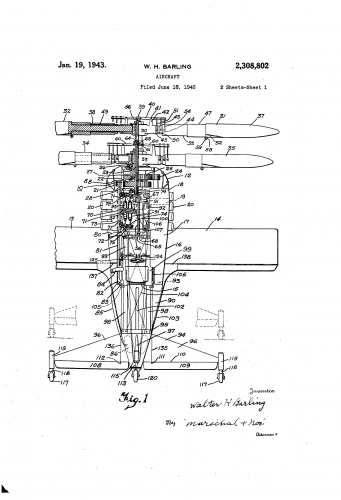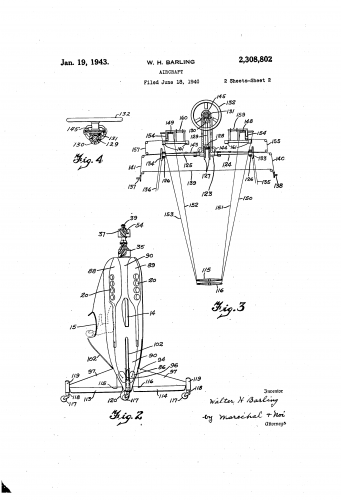W
Wingknut
Guest
This one is a tail-sitter VTOL aircraft patent, filed by Walter Barling. (He of XNBL-1 triplane bomber fame: http://www.secretprojects.co.uk/forum/index.php/topic,12991.msg275383.html#msg275383)
Filed June 18th, 1940, http://www.google.co.uk/patents/US2308802
“One object of the invention is the provision of an aircraft adapted for high speed travel in normal flight and capable of taking off and landing in a substantially vertical direction.
Another object of the invention is the provision of an aircraft adapted to take off and land substantially vertically, and having a tail structure which is movable axially of the body, with a shock absorbing connection between tail structure and the body for effectively cushioning the shock of landing. …
Another object of the invention is the provision of an aircraft having a lifting propeller and capable of substantailly [sic] vertical flight, the propeller driving engine or engines being releasably connected to the aircraft body on which the propeller is rotatable so that the engines may descend independently of the aircraft body in case of engine failure.”
Filed June 18th, 1940, http://www.google.co.uk/patents/US2308802
“One object of the invention is the provision of an aircraft adapted for high speed travel in normal flight and capable of taking off and landing in a substantially vertical direction.
Another object of the invention is the provision of an aircraft adapted to take off and land substantially vertically, and having a tail structure which is movable axially of the body, with a shock absorbing connection between tail structure and the body for effectively cushioning the shock of landing. …
Another object of the invention is the provision of an aircraft having a lifting propeller and capable of substantailly [sic] vertical flight, the propeller driving engine or engines being releasably connected to the aircraft body on which the propeller is rotatable so that the engines may descend independently of the aircraft body in case of engine failure.”


